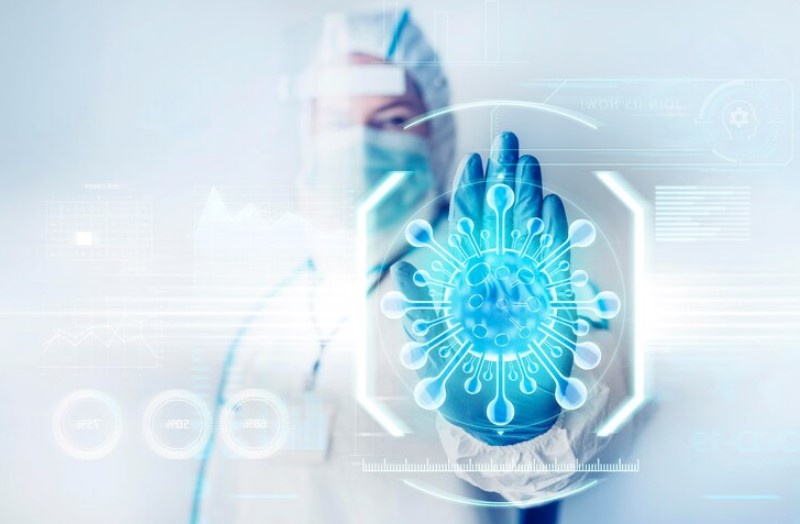Microbes, encompassing bacteria, viruses, fungi, and other microscopic organisms, play a pivotal role in various ecosystems. While many microbes are beneficial, some can pose severe threats to human health, agriculture, and industries. The identification, prevention, and inactivation of these harmful microbes have become a critical focus in public health and scientific research. Technological advancements have significantly transformed our ability to combat these microbes effectively.
What is the Technology for Microbial Identification?
Microbial identification relies on microscopy (light and electron) for structure visualization, PCR and DNA sequencing for genetic analysis, and spectroscopy (mass spectrometry, infrared) to detect unique microbial patterns. Integrating Artificial Intelligence with machine learning algorithms enhances data analysis, enabling rapid and precise identification crucial in disease diagnosis, food safety, and pharmaceutical development.
Role of Artificial Intelligence (AI) in Microbial Identification
Artificial Intelligence (AI) stands as a transformative force in microbial identification, leveraging machine learning algorithms to swiftly process extensive datasets. This enables AI to recognize and categorize distinctive features within microbial samples, automating precise identifications of diverse species and strains. By adeptly discerning nuanced differences among microbes, AI-driven pattern recognition expedites diagnostics and classifications. This proactive approach equips us to better combat microbial threats, predict outbreaks, and implement preemptive measures for improved disease management and environmental conservation.
Technologies for Microbial Identification
In the realm of microbial identification, several innovative technologies play pivotal roles.
- Microscopy: Traditional microscopy techniques like light and electron microscopy have been instrumental in visualizing microbes. These methods allow scientists to observe their morphology and structure, aiding in initial identification.
- Molecular Techniques: Polymerase Chain Reaction (PCR) and DNA sequencing have revolutionized microbial identification. PCR enables the amplification of specific DNA segments, while DNA sequencing provides precise identification by analyzing genetic material.
- Spectroscopy: Techniques such as mass spectrometry and infrared spectroscopy offer rapid and accurate identification by analyzing the unique spectral patterns of microbes.
- Artificial Intelligence (AI): Machine learning algorithms process vast amounts of microbial data, enabling pattern recognition and predictive analytics for efficient identification. Integrating AI with these techniques has substantially enhanced our ability to swiftly and accurately identify a diverse range of microbes, crucial for disease diagnosis, food safety, and environmental monitoring.
Technologies for Microbial Prevention
When it comes to preventing the proliferation of harmful microbes, several advanced techniques have emerged as crucial pillars of defense.
- Sterilization Techniques: Heat-based methods and chemical sterilants stand as widely employed strategies to eliminate microbes from various surfaces, medical equipment, and food products, ensuring their safety and efficacy.
- Vaccines and Immunization: The development and deployment of vaccines have been instrumental in preventing infectious diseases. Advancements in vaccine technology have led to safer and more effective immunization strategies, significantly reducing the spread and impact of microbial illnesses.
- Nanotechnology: Nanoparticles, with their inherent antimicrobial properties, present a promising avenue for combating microbes. These tiny structures exhibit remarkable capabilities in targeting and neutralizing harmful microbes, offering potential applications across diverse fields, from healthcare to food safety.
Can Technology Revolutionize Microbial Control?
Advanced technology presents a transformative opportunity in microbial control. Innovations like PCR, DNA sequencing, AI-driven analytics, and nanotechnology promise rapid, precise identification, proactive prevention, and reshaping disease management. These advancements offer potential in bolstering food safety, ensuring sustainability, and efficiently combating microbial threats, marking a significant leap in safeguarding global well-being.
Conclusion
The integration of diverse technological advancements in microbial identification and prevention stands as an emblem of progress in the fight against microbial threats. From the precision of molecular techniques like PCR and DNA sequencing to the depth of AI-driven analytics and the promise of nanotechnology, these tools synergize to bolster our capacity to identify, prevent, and neutralize harmful microbes. This collective technological prowess not only aids in disease diagnosis, food safety, and pharmaceutical development but also underpins proactive measures for disease control and environmental sustainability.


Comments (5)